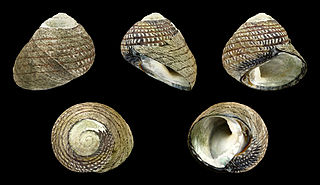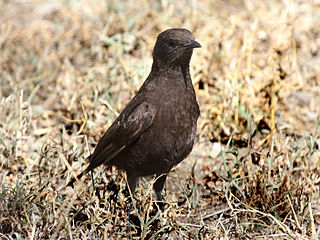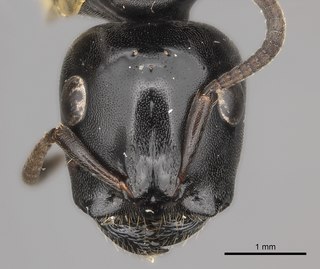
The vervet monkey, or simply vervet, is an Old World monkey of the family Cercopithecidae native to Africa. The term "vervet" is also used to refer to all the members of the genus Chlorocebus. The five distinct subspecies can be found mostly throughout Southern Africa, as well as some of the eastern countries. These mostly herbivorous monkeys have black faces and grey body hair color, ranging in body length from about 40 cm (16 in) for females, to about 50 cm (20 in) for males.

Chlorocebus is a genus of medium-sized primates from the family of Old World monkeys. Six species are currently recognized, although some people classify them all as a single species with numerous subspecies. Either way, they make up the entirety of the genus Chlorocebus.

The grivet is an Old World monkey with long white tufts of hair along the sides of its face. Some authorities consider this and all of the members of the genus Chlorocebus to be a single species, Cercopithecus aethiops. As here defined, the grivet is restricted to Ethiopia, Sudan, Djibouti, and Eritrea. In the southern part of its range, it comes into contact with the closely related vervet monkey and Bale Mountains vervet. Hybridization between them is possible, and may present a threat to the vulnerable Bale Mountains vervet. Unlike that species, the grivet is common and rated as least concern by the IUCN.

The Scotch argus is a butterfly of the family Nymphalidae. In spite of its English name argus, it is not a close relation of the brown argus nor the northern brown argus.
The terms Aethiops, Ethiop, or Ethiope are archaic words for "burnt face." It may refer to:

Vero cells are a lineage of cells used in cell cultures. The 'Vero' lineage was isolated from kidney epithelial cells extracted from an African green monkey. The lineage was developed on 27 March 1962 by Yasumura and Kawakita at the Chiba University in Chiba, Japan. The original cell line was named Vero after an abbreviation of verdareno, which means 'green kidney' in Esperanto, while vero itself means 'truth' in Esperanto.

Diloma aethiops, whose common names include scorched monodont, spotted black topshell, and in the Māori language pūpū, pūpū-mai, or māihi is a species of small sea snail, a marine gastropod mollusc in the family Trochidae, subfamily Monodontinae.

The anteater chat or northern anteater-chat is a species of bird in the family Muscicapidae.It is found in Burkina Faso, Cameroon, Central African Republic, Chad, Gambia, Kenya, Mali, Mauritania, Niger, Nigeria, Senegal, Sudan, and Tanzania. Its natural habitats are dry savanna, subtropical or tropical dry lowland grassland, and subtropical or tropical high-altitude grassland.

The white-shouldered antshrike is a species of bird in subfamily Thamnophilinae of family Thamnophilidae, the "typical antbirds". It is found in Bolivia, Brazil, Colombia, Ecuador, Peru, and Venezuela.
Raynor Taylor was an English organist, music teacher, composer, and singer who lived and worked in the United States after emigrating in 1792. Active in composing music for the theater, outdoor pleasure garden, and the Anglican Church and Protestant Episcopal Church of the United States, he was one of the first notable composers active in America.

Oligia fasciuncula, the middle-barred minor, is a moth of the family Noctuidae. It is found in Europe.

Amauris niavius, the friar, is a butterfly of the family Nymphalidae. It is found in the forests of tropical Africa.

Protogoniomorpha parhassus, the forest mother-of-pearl or common mother-of-pearl, is a species of Nymphalidae butterfly found in forested areas of Africa.
Pseudonacaduba aethiops, the dark line blue or dark African line blue, is a butterfly in the family Lycaenidae. It is found in Africa from Nigeria to western Kenya and Zambia. The habitat consists of forests.
Hypopta aethiops is a moth in the family Cossidae. It is found in South America.

Ceroplesis aethiops is a species of beetle in the family Cerambycidae. It was described by Johan Christian Fabricius in 1775. It is known from South Africa. It contains the variety Ceroplesis aethiops var. quadrimaculata.

Dorcadion aethiops is a species of beetle in the family Cerambycidae. It was described by Scopoli in 1763, originally under the genus Cerambyx. It is known from the Czech Republic, Albania, Greece, Bulgaria, Croatia, Hungary, Slovakia, North Macedonia, Romania, Austria, Turkey, Serbia, and Ukraine.

Cereus aethiops is a species of cactus found from Uruguay to Argentina.

Endelomyia aethiops, the roseslug, is a species of common sawfly in the family Tenthredinidae.

Tetraponera aethiops is a species of ant in the subfamily Pseudomyrmecinae, which is native to tropical Africa. It is found living in the forest in association with Barteria fistulosa, a small tree.















